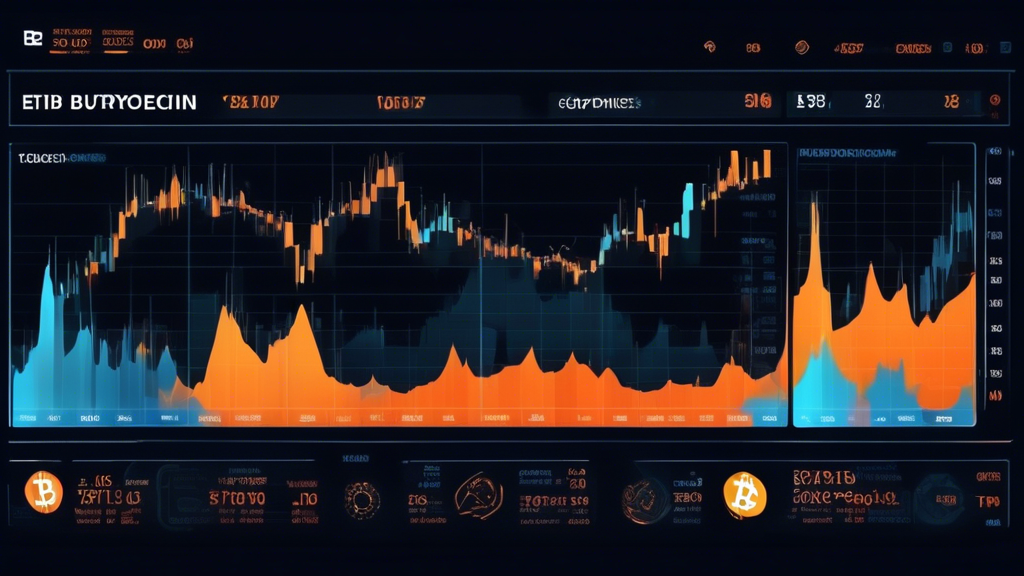Introduction
The cryptocurrency market today is a dynamic and rapidly evolving ecosystem, capturing the attention of both seasoned investors and newcomers alike. As digital assets continue to gain prominence, understanding the current trends driving the cryptocurrency market has become more crucial than ever. From the sudden price swings characteristic of market volatility to groundbreaking technological advancements, the landscape of cryptocurrencies is being reshaped at an unparalleled pace.
This article will delve into the significant factors contributing to the volatility in the cryptocurrency market today, examining how global events and regulatory changes are influencing investment strategies. Furthermore, we will explore the role of emerging technologies such as blockchain, DeFi, and NFTs in shaping the future of cryptocurrencies. Lastly, we will assess the growing interest from institutional investors, discussing how this affects trading practices and predicting the long-term outlook for the cryptocurrency market today.
Join us as we navigate the complexities and opportunities within the cryptocurrency market, providing valuable insights for anyone looking to understand this rapidly changing industry.
Understanding the Volatility in the Cryptocurrency Market Today
The cryptocurrency market today is characterized by its notorious volatility, presenting both challenges and opportunities for investors worldwide. As digital currencies have become a focal point of global financial discourse, the factors contributing to their volatile nature have gained significant attention. Understanding these factors is crucial for anyone looking to navigate the tumultuous waters of the cryptocurrency landscape effectively.
Factors Contributing to the Current Volatility in the Cryptocurrency Market
The cryptocurrency market today is subject to a myriad of influences that contribute to its volatility. One primary factor is the speculative nature of cryptocurrencies. Unlike traditional assets, digital currencies often see large price swings driven by speculation, news developments, and market sentiment rather than underlying fundamentals.
Secondly, the supply and demand dynamics are a critical driver of price volatility. Since many cryptocurrencies have a limited supply cap, their prices can be heavily influenced by changes in investor interest or adoption rates. This is evident in how news events, celebrity endorsements, or company announcements can lead to sudden spikes or drops in value.
Additionally, the relatively low liquidity in comparison to conventional markets can exacerbate price fluctuations. Large-scale transactions can significantly impact the value of cryptocurrencies, leading to greater volatility compared to more liquid markets where trades are absorbed with minimal impact.
The Impact of Global Events, Regulatory Changes, and Technological Advancements
Global events and macroeconomic factors have a profound impact on the cryptocurrency market today. For instance, geopolitical tensions, economic instability, and inflation concerns can drive investors towards or away from digital assets. During uncertain times, cryptocurrencies are often perceived either as a safe haven or a risky speculative bet, affecting their volatility.
Regulatory changes and government policies are another potent catalyst for market volatility. Cryptocurrencies operate in a regulatory gray area in many regions, and any shift towards stricter regulations or outright bans can cause panic and drastic market reactions. Conversely, favorable regulatory developments can engender positive sentiment and price surges.
Technological advancements also play a critical role. Breakthroughs in blockchain technology, security enhancements, and the introduction of new cryptocurrencies or features can all lead to volatility. For example, the implementation of decentralized finance (DeFi) platforms and improvements in scalability and transaction speeds have spurred new waves of investor activity.
Strategies for Navigating the Cryptocurrency Market’s Volatility
Given the inherent volatility of the cryptocurrency market today, investors have developed a variety of strategies to manage risk and capitalize on potential opportunities. One such strategy is diversification. By spreading investments across various cryptocurrencies and blockchain-related assets, investors can mitigate the risks associated with any single asset’s volatility.
Hedging is another common approach, where investors use financial instruments like options and futures to offset potential losses. This strategy requires a sophisticated understanding of derivatives markets but can protect portfolios from significant downturns.
Long-term investment and holding strategies, often referred to as HODL, are popular among those who believe in the enduring value of cryptocurrencies. This approach involves holding assets through market fluctuations with the expectation that their value will increase over an extended period.
Finally, staying informed and agile is indispensable. Investors should continuously monitor market news, regulatory updates, and technological announcements. Utilizing stop-loss orders and maintaining a disciplined approach to buying and selling can also help investors manage the short-term volatility effectively.
The cryptocurrency market today presents a complex and dynamic environment for investors. By understanding the factors driving volatility and employing robust strategies, investors can better navigate this unpredictable market, capitalizing on its potential while mitigating risks.
Emerging Technologies Shaping the Cryptocurrency Market Today
The cryptocurrency market today is not only marked by its volatility but also by revolutionary technologies transforming its landscape. As digital currencies continue to capture global attention, the underlying technologies are evolving at an unprecedented pace, opening new avenues for innovation and investment opportunities. This article delves into the cutting-edge technologies and innovations that profoundly influence the cryptocurrency market today.
The Role of Blockchain Developments
At the heart of the cryptocurrency market today is blockchain technology. Blockchain’s foundational promise of decentralization, transparency, and security is pivotal in driving the cryptocurrency ecosystem. Recent developments have seen the introduction of improved protocols and solutions addressing key concerns such as scalability and energy consumption.
Ethereum 2.0, for instance, represents a monumental shift towards more sustainable crypto operations with its transition from a proof-of-work to a proof-of-stake consensus mechanism. This upgrade significantly reduces energy consumption, making blockchain operations more eco-friendly. Additionally, Layer 2 solutions like the Lightning Network have made transactions faster and cheaper, further expanding blockchain’s utility beyond cryptocurrencies to applications in supply chain management, healthcare, and beyond.
Decentralized Finance (DeFi) as a Game-Changer
The rise of decentralized finance, or DeFi, is one of the most significant trends in the cryptocurrency market today. DeFi leverages blockchain technology to recreate and enhance traditional financial systems such as lending, borrowing, and trading — all without the need for centralized intermediaries. This democratization of financial services empowers individuals to participate in a global financial system with reduced barriers.
The proliferation of DeFi platforms like Uniswap, Aave, and Compound has skyrocketed over the past few years, unlocking new forms of passive income through yield farming and liquidity provision. These platforms are not only fostering financial inclusion but are also relentlessly innovating with smart contracts that automate complex financial transactions securely and transparently. As a result, DeFi continues to redefine financial interaction within the cryptocurrency market today.
The Surge of Non-Fungible Tokens (NFTs)
Non-fungible tokens, or NFTs, have taken the digital world by storm, becoming one of the most talked-about elements in the cryptocurrency market today. NFTs represent unique digital assets verified on the blockchain, ranging from digital art and music to virtual real estate and collectibles. This digital proof of authenticity and ownership has unleashed a new wave of creativity and monetization in various industries.
The explosion of NFT platforms like OpenSea, Rarible, and Foundation exemplifies the potential for creators to reach global audiences and monetize their content directly. While the NFT debate continues regarding their sustainability and value, their influence on digital ownership and creative industries remains undeniable, sparking new opportunities in the cryptocurrency market today.
Driving New Opportunities and Trends
The symbiosis of blockchain, DeFi, and NFT technologies has given rise to innovative financial products and services, influencing the cryptocurrency market today. Beyond digital currencies, the integration of these technologies into everyday life is becoming increasingly apparent, from decentralized insurance and prediction markets to tokenized real-world assets.
Moreover, the interoperability between different blockchains — allowing them to communicate and share information seamlessly — is another frontier driving efficiency and collaboration within the market. Projects focused on interoperability, such as Polkadot and Cosmos, aim to create a truly interconnected blockchain ecosystem, thus broadening the scope and functionality of cryptocurrencies.
In conclusion, the cryptocurrency market today is being reshaped by groundbreaking technologies fostering a more inclusive, efficient, and sustainable digital economy. These innovations are not only expanding the functionality of digital currencies but are also paving the way for new business models and financial systems. For investors and enthusiasts, staying abreast of technological advancements is crucial to unlocking the myriad opportunities presented by this dynamic market.
The Future of Investment and Trading in the Cryptocurrency Market Today
The cryptocurrency market today is witnessing a paradigm shift as it steadily garners attention from institutional investors and mainstream financial entities. This increased interest marks a pivotal moment in the evolution of digital assets, driving new dynamics in investment strategies and trading practices. As cryptocurrencies continue to ingratiate themselves into the fabric of global finance, several key factors are shaping the future of investment and trading in this volatile yet promising market.
Institutional Investors: A New Dawn in the Cryptocurrency Market
The cryptocurrency market today is increasingly being driven by institutional investors such as hedge funds, asset managers, and even some legacy banks. This institutional interest is not just a fleeting trend but a significant force that is expected to stabilize and legitimize the market in the long term. Institutions are attracted by the high returns and diversification benefits that digital currencies offer, alongside emerging investment instruments like cryptocurrency exchange-traded funds (ETFs) that provide regulated avenues for investment.
This growing institutional interest is likely to bring about greater liquidity and possibly reduce the pronounced volatility synonymous with the cryptocurrency market. As institutional investors bring in larger capital inflows and demand for safer, more regulated trading mechanisms, there is a collective push towards more robust regulatory frameworks and custodial solutions. The presence of these sophisticated players indicates a maturation of the market, potentially leading to a more stable investment environment for all market participants.
Shifts in Trading Practices: What It Means for Individual Investors
The rise of institutional participation is directly influencing trading practices within the cryptocurrency market today. Algorithmic trading and advanced quantitative strategies common in traditional financial markets are increasingly being adapted for crypto assets. For individual investors, this shift may mean facing stiffer competition when trying to capitalize on short-term market movements. However, it also opens up unique opportunities to learn from and align with institutional methodologies.
Moreover, the increased use of derivatives and options within the cryptocurrency market provides diverse strategies for risk management and speculation. These sophisticated financial products allow investors to hedge against market volatility and design more resilient portfolios. As education and access improve, individual investors are expected to integrate these complex tools into their trading arsenals, empowering even retail participants to achieve more consistent returns.
Predicting Future Trends and the Long-term Outlook
Looking ahead, one can anticipate several prevailing trends and transformative shifts in the cryptocurrency market today. A critical development is the potential for further mainstream adoption as payment solutions and platforms continue to bridge the divide between digital assets and everyday use. Technologies like the Lightning Network for Bitcoin and Ethereum 2.0’s enhancements are pivotal in making cryptocurrencies more viable for daily transactions, enhancing their utility and attractiveness to global consumers.
In addition, regulatory landscapes worldwide are shifting toward more comprehensive frameworks that seek to balance innovation with consumer protection. Legislative changes, such as those being enacted in regions like the European Union with MiCA (Markets in Crypto-Assets Regulation), might serve as blueprints for other nations, thereby ensuring more unified and secure environments for market engagement. Such regulations are essential for fostering a sustainable growth trajectory while mitigating risks associated with fraud, market manipulation, and cybersecurity threats.
The long-term outlook of the cryptocurrency market hinges on several other factors, including technological advancements, macroeconomic variables, and geopolitical stability. As trust and technological capabilities improve, digital assets could potentially transform into cornerstone components of diversified investment portfolios. While the path may be fraught with challenges, the current direction suggests a bright future replete with possibilities for investors, developers, and consumers interested in the burgeoning technology sector.
Ultimately, those investing and trading in the cryptocurrency market today must remain agile, informed, and prepared to adapt to rapid changes. Exciting though it is, the cryptocurrency landscape demands a deep understanding and strategic approach to navigate effectively. As the market marches toward maturity, its evolution will irrevocably shape the future of global finance, embodying both an opportunity and a challenge for current and prospective investors alike.
Conclusion
As we’ve navigated through the layers defining the cryptocurrency market today, it is evident that this dynamic space is at an intriguing crossroads. The factors contributing to the volatility in this market, such as global events, regulatory shifts, and rapid technological advancements, continue to challenge and captivate investors. As a result, both seasoned and novice investors are exploring diverse strategies to mitigate risks and leverage potential opportunities.
The Role of Emerging Technologies
Emerging technologies are undeniably reshaping the cryptocurrency landscape. The proliferation of blockchain innovations, decentralized finance (DeFi) platforms, and non-fungible tokens (NFTs) are not only revolutionizing traditional financial models but also creating unprecedented avenues for growth and speculation. These advancements signal a persistent trend where technological evolution continually reshapes market dynamics, offering investors and enthusiasts alike new possibilities to explore.
The Future Outlook
The increased interest from institutional players and the growing mainstream adoption of digital currencies suggest a promising future for the cryptocurrency market today. This shift heralds potential changes in trading practices and investor demographics, as more traditional financial institutions begin to embrace the digital currency realm. As we look forward, the market is poised for further transformation, with impending legislative changes likely to redefine norms and frameworks governing this space.
In essence, while the cryptocurrency market today remains a hotbed of volatility and innovation, the evolving nature of technologies and investments underscores both challenges and opportunities. Staying informed and adaptable will be key for anyone vested in this rapidly evolving market. As the landscape continues to mature, it offers a bold and exciting frontier for those willing to navigate its complexities.



